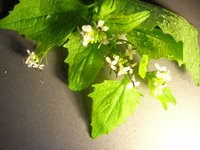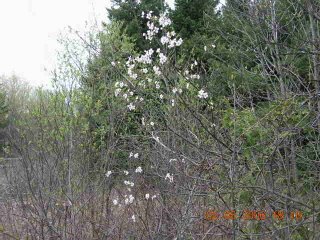One tends to fear those things unkown more than anything. The purple loosestrife episode is behind me. In the past I covered considerable posts on purple loosestrife which is now happily under control due to an introduced beetle. This spring when the beetle emerges I will post a photo of it now that I have the means to take close up photos.
My new invasive species project will be on garlic mustard. I have for the last day or so spent considerable time finding out how to properly dispose of the garlic mustard plants.
The Andirondack Park Invasive Plant Program is one of the best sites I have found so far. See: http://www.adkinvasives.com/Terrestrial/Ecology/Ecology.html. It also provides a best management practices that you can down load as a word document. It also covers a number of other invasive plants that do not seem to be too much of a problem here, like Japanese Knotweed.
I have cut and pasted a portion of the text from document BMPs3-06 Appendix A, of the above website entitled Best Management Practices.
CONTROL METHODS FOR GARLIC MUSTARD (Alliaria petiolata)
PLANT DESCRIPTION
Garlic mustard is a naturalized European biennial herb that typically invades partially shaded forested and roadside areas. It is capable of dominating the ground layer and excluding other herbaceous species. Its seeds germinate in early spring and develops a basal rosette of leaves during the first year. Garlic mustard produces white, cross-shaped flowers between late April and June of the following spring. Plants die after producing seeds, which typically mature and disperse in August. Normally its seeds are dormant for 20 months and germinate the second spring after being formed. Seeds remain viable for up to 7 years.
MANAGEMENT OPTIONS
1. Pulling.
Effectiveness:
Hand pulling is an effective method for removing small populations of garlic mustard, since plants pull up easily in most forested habitats. It is best to pull plants when seed pods are not yet mature, but they can be pulled during most of the year.
Methods:
Soil should be tamped down firmly after removing the plant. Soil disturbance can bring existing garlic mustard seed bank to the surface, thus creating a favorable environment for additional germination within the control site.
Cautions:
Care should be taken to minimize soil disturbance but to remove all root tissues. Re-sprouting may occur from mature plants root systems if not entirely removed. Cutting is preferred to pulling when garlic mustard infestations are interspersed amongst native grasses/forbs or other sensitive or rare flora.
Disposal:
If plants have capsules present, they should be bagged and disposed of to prevent seed dispersal. Bag all plant parts & remove from site (compost at DOT Residency, dispose of in approved landfill or incinerate with appropriate permits).
Sanitation:
Clean all clothing, boots, & equipment to prevent spread of seed.
2. Cutting
Effectiveness:
Cutting is effective for medium-to large-sized populations depending on available time and labor resources. Dormant seeds in the soil seed bank are unaffected by this technique due to minimal disturbance of the soil.
Methods:
Cut stems when in flower (late spring/early summer) at ground level either manually (with clippers or a scythe) or with a motorized string trimmer. This technique will result in almost total mortality of existing plants and will minimize re-sprouting.
Cautions:
Cuttings should be conducted annually for 5 to 7 years or until the seed bank is depleted.
Disposal:
Cut stems should be removed from the site when possible since they may produce viable seed even when cut. Bag all plant parts & remove from site (compost at DOT Residency, dispose in approved landfill or incinerate with appropriate permits).
Sanitation:
Clean all clothing, boots, & equipment to prevent spread of seed.
3. Herbicide
Effectiveness:
Roundup will not affect subsequent seedling emergence of garlic mustard or other plants.
Methods:
Use glyphosate formulations only. Should be applied after seedlings have emerged, but prior to flowering of second-year plants. Application should be by spray bottle or wick applicator for individual spot treatments.
Cautions:
This herbicide is not selective (kills both monocots & dicots), thus should be applied carefully to prevent killing of non-target species. All tank mixes should be mixed with clean (ideally distilled) water because glyphosate binds tightly to sediments, which reduces toxicity to plants.
Do not apply in windy conditions because spray will drift and kill other plants. Do not apply if rain is forecast w/in 12 hours because herbicide will be washed away before it can act. Choose Rodeo® formulation for applications in standing water or along a shoreline.
-------






